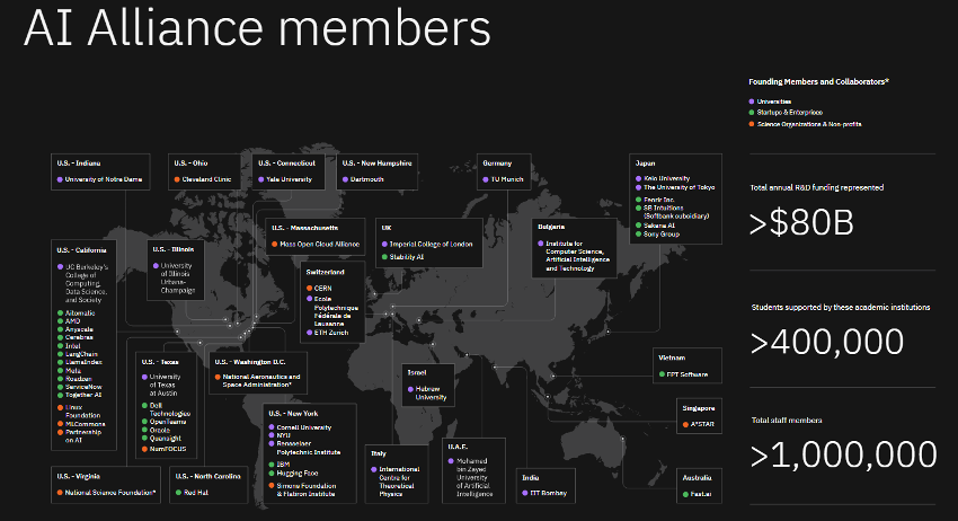The AI Alliance was initially launched in December 2023 with more than 50 founding members. This month the alliance announced that nearly 30 more new members have joined the organization.
The AI Alliance represents a worldwide assembly of companies, universities and other research institutions, agencies and nonprofits assembled to promote responsible and ethical artificial intelligence. The alliance’s goals are to facilitate open collaboration, shape governance guardrails for AI, provide testing and benchmarking tools, advocate policy positions, further education and foster hardware ecosystems.
The Alliance also announced that it has established its first two working groups, the AI Safety and Trust Tooling work group and the AI Policy Advocacy work group. The AI Safety and Trust Tooling working group will provide information and best practice guidance on AI safety, trust, ethics and cybersecurity. The group will also be responsible for tools, blogs, newsletters and whitepapers. The experts in that group will improve tools that evaluate sensitive data detection, model quality, alignment and cybersecurity threats. It will also establish benchmarks for testing AI models and applications.
The AI Policy Advocacy working group will create public forums, using technical experts and policymakers to discuss opportunities and barriers for open AI innovation. It will also publish AI Alliance information and opinions on key policy topics that promote open source and open innovation. The group’s overall objective is to influence policymakers and promote responsible AI practices.

IBM
Important companies not in the alliance
The formation of the AI Alliance was initiated by IBM and Meta with the objective of building a strong and capable open baseline for AI to meet challenges such as governance, supply chain issues and privacy concerns. The membership includes notable tech giants, AI providers and other institutions such as Intel, Oracle, Cornell, AMD, the National Science Foundation, Dell, Hugging Face, Red Hat, Stability AI, ServiceNow and more.
Strategically, the alliance represents a collaborative industry-wide counterbalance to the market forces of prominent non-member AI companies such as Google, Microsoft, Nvidia and OpenAI. Once the alliance achieves full traction within the industry, it will begin to exert its influence on regulatory issues. That’s when the absence of influential companies including the ones just mentioned may result in markets and regulations being shaped in favor of the AI Alliance and its objectives.
The AI Alliance plans to create an AI hardware accelerator ecosystem, testing and benchmarking tools for AI deployment with an emphasis on open AI policies. The Alliance is also interested in defining model scaling in terms of size, accuracy, cost and sustainability—issues that are important to obtain a balanced approach to model complexity and utility.
The newly added AI Alliance Members Include:
- Anaconda
- Applied Digital
- Citadel AI
- Core42
- Databricks
- Domino Data Lab
- ESADE
- Hitachi
- Institut Polytechnique de Paris
- Impact AI
- Kera Health Platforms
- LastMile AI
- Lightning AI
- MLOps Community
- NEC Corporation
- New Native Inc.
- Neo4j
- Northeastern University
- Predibase
- SeedAI
- Snowflake, Inc.
- Uber
- University at Buffalo
- University of Pennsylvania
- University of Technology in Poznan: Interdisciplinary Centre for Artificial Intelligence and Cybersecurity
- University of Utah
- Weights & Biases
- Zilliz























































































